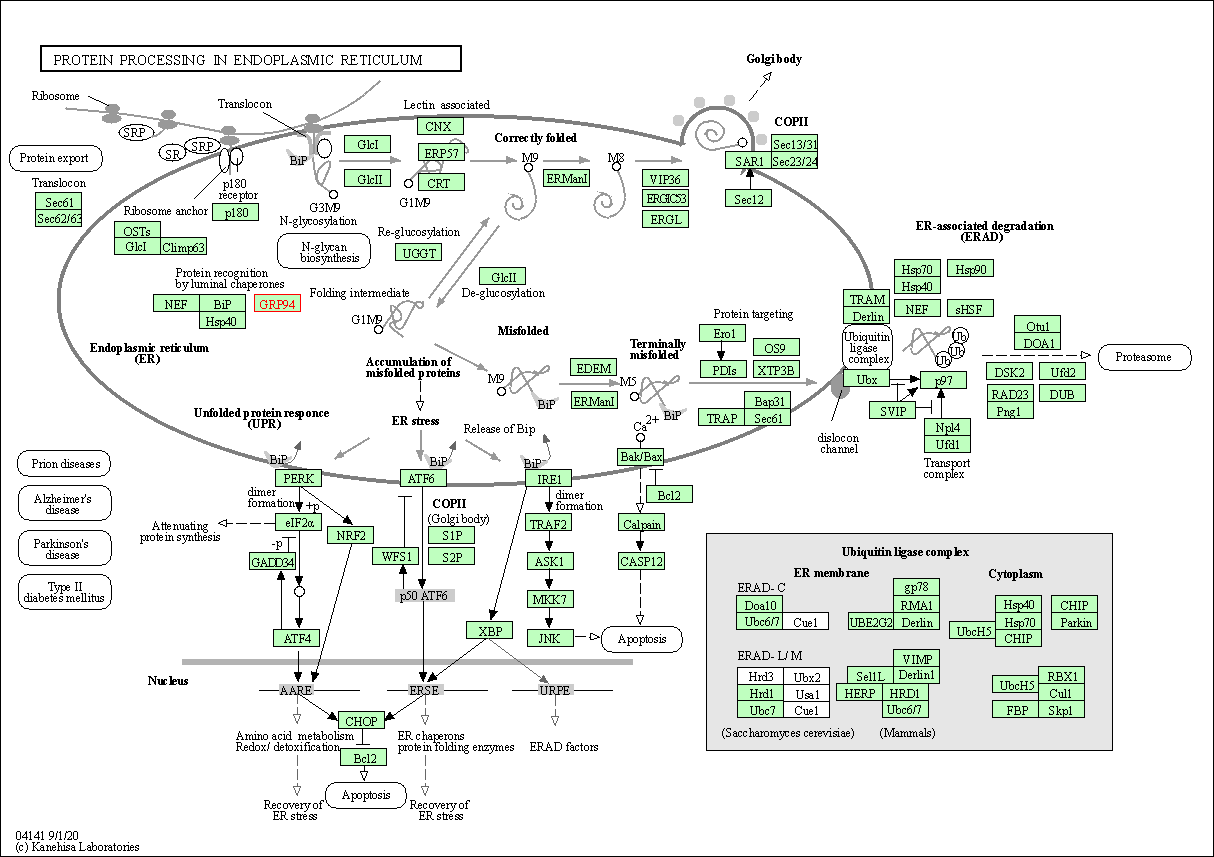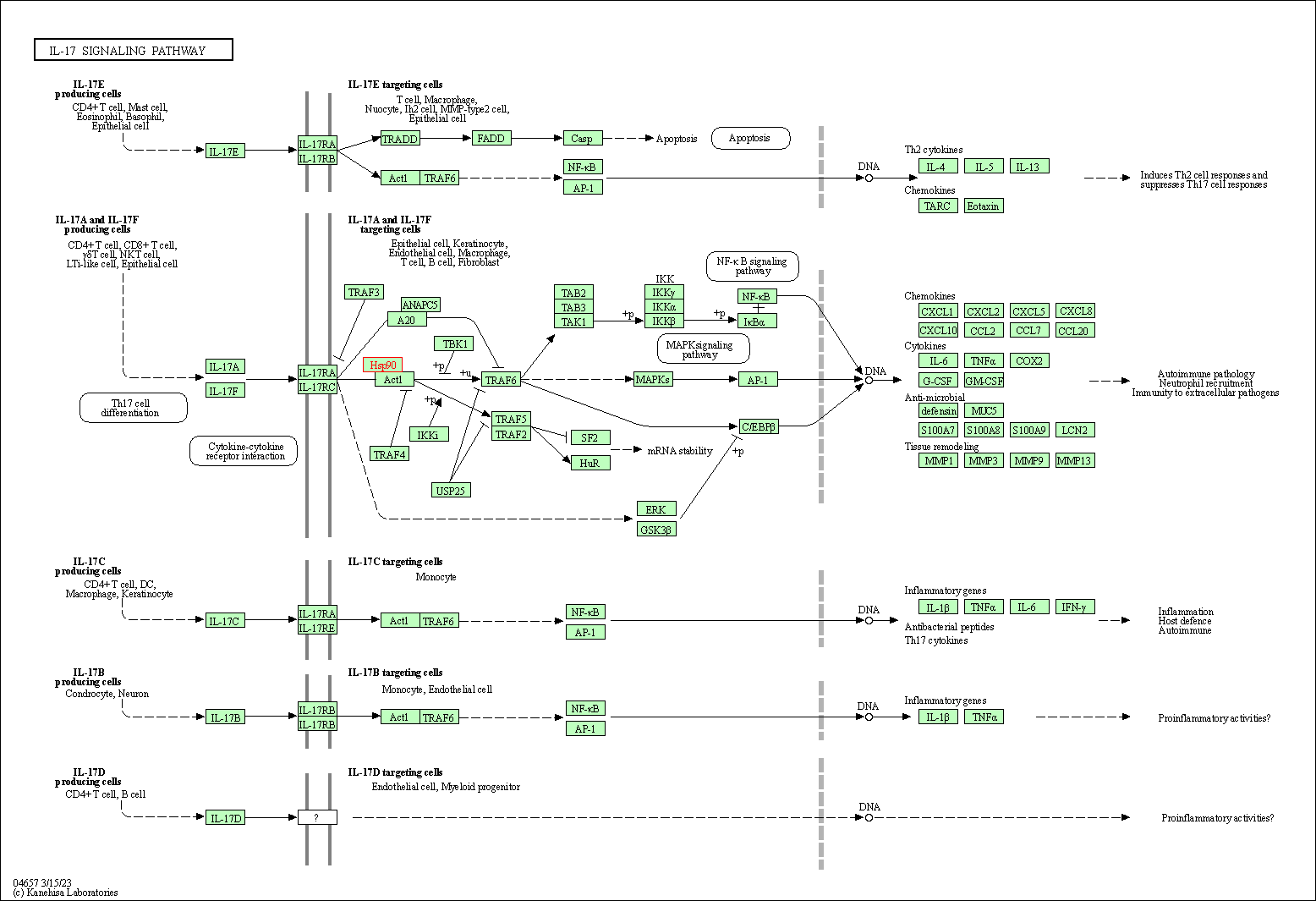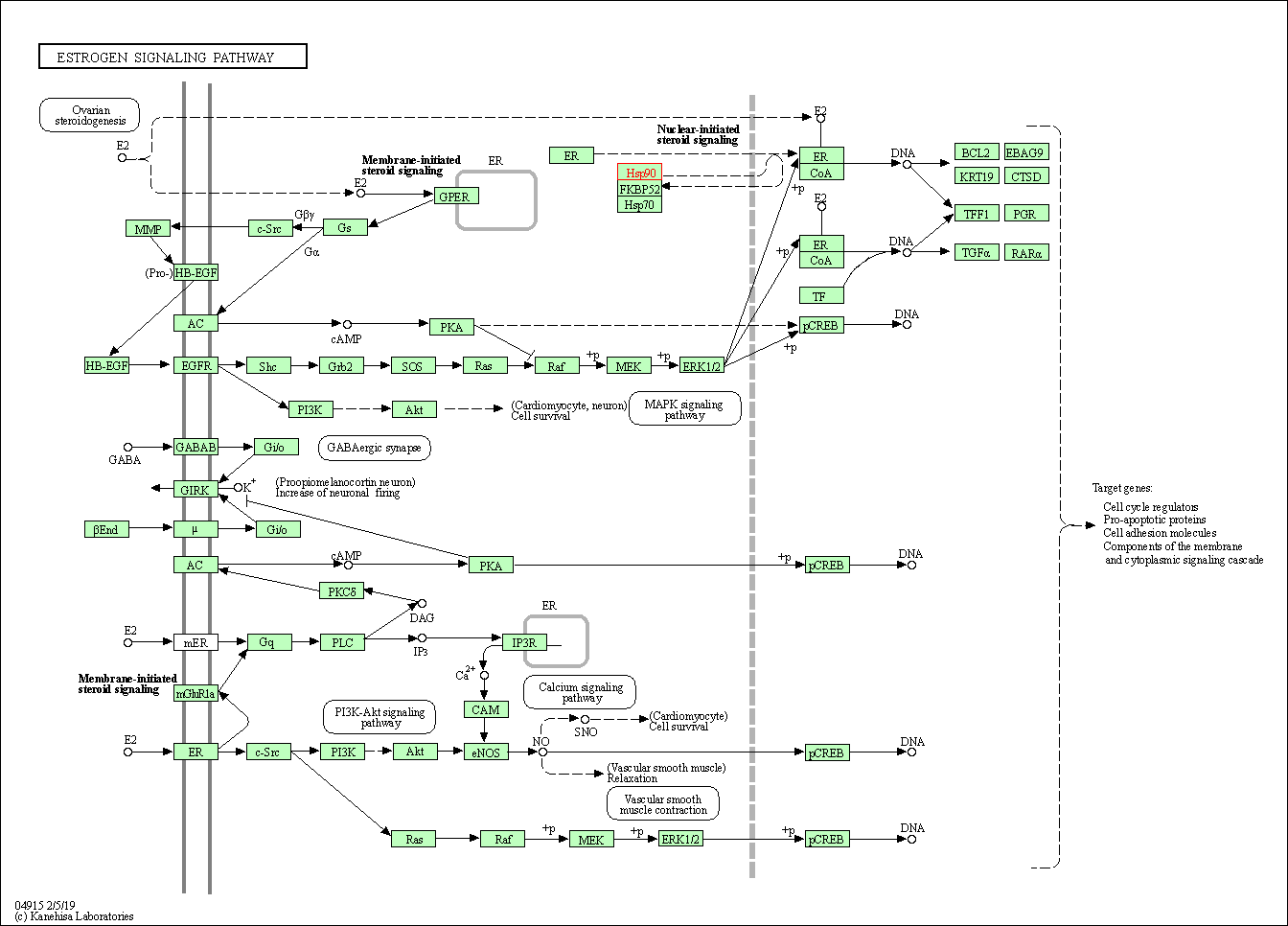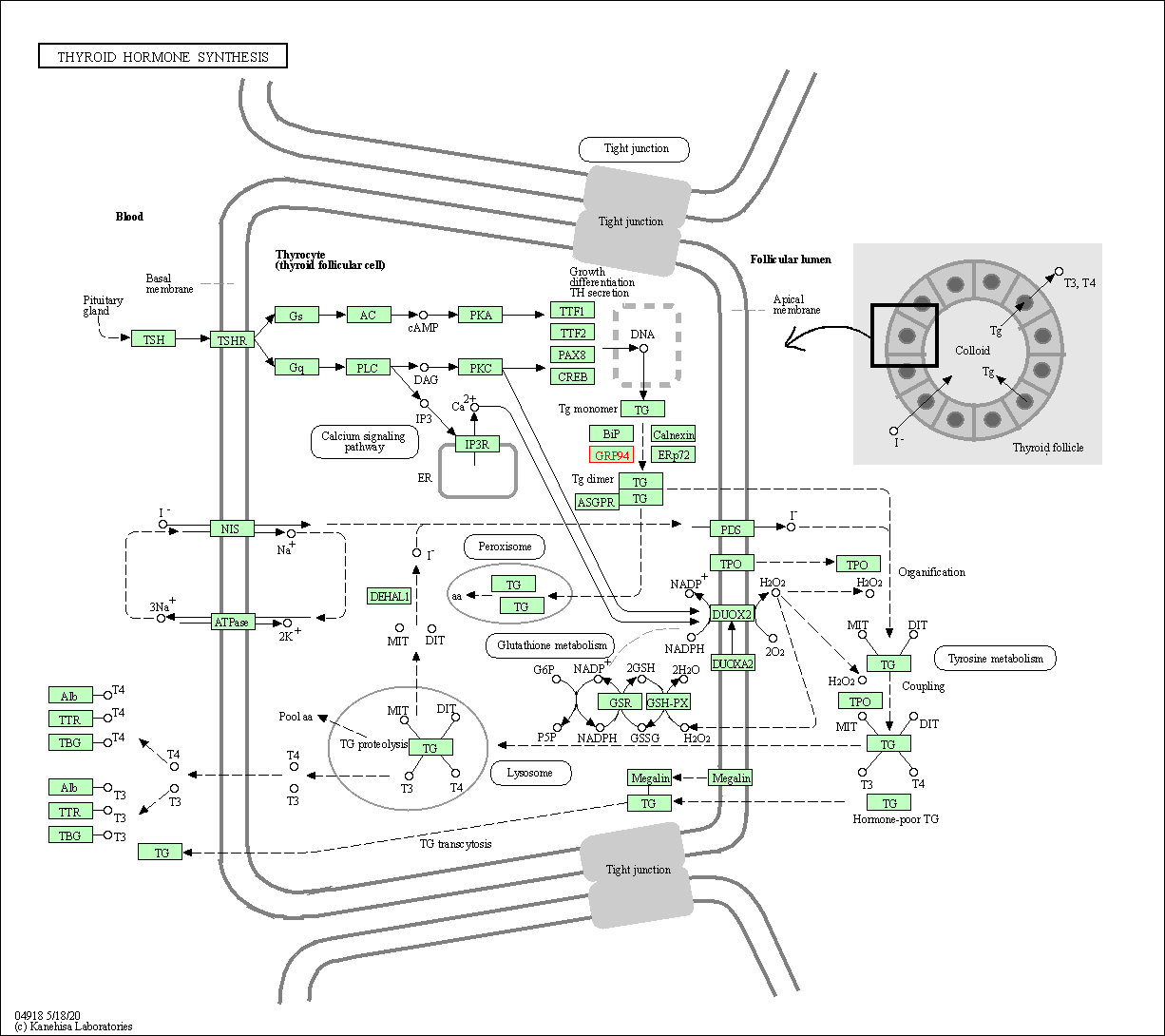Target Information
| Target General Information | Top | |||||
|---|---|---|---|---|---|---|
| Target ID |
T81311
(Former ID: TTDI01987)
|
|||||
| Target Name |
Endoplasmin (HSP90B1)
|
|||||
| Synonyms |
gp96 homolog; Tumor rejection antigen 1; TRA1; Heat shock protein 90 kDa beta member 1; GRP94; GRP-94; 94 kDa glucoseregulated protein; 94 kDa glucose-regulated protein
Click to Show/Hide
|
|||||
| Gene Name |
HSP90B1
|
|||||
| Target Type |
Clinical trial target
|
[1] | ||||
| Disease | [+] 1 Target-related Diseases | + | ||||
| 1 | Lung cancer [ICD-11: 2C25] | |||||
| Function |
When associated with CNPY3, required for proper folding of Toll-like receptors. Functions in endoplasmic reticulum associated degradation (ERAD). Has ATPase activity. Molecular chaperone that functions in the processing and transport of secreted proteins.
Click to Show/Hide
|
|||||
| BioChemical Class |
Heat shock protein
|
|||||
| UniProt ID | ||||||
| Sequence |
MRALWVLGLCCVLLTFGSVRADDEVDVDGTVEEDLGKSREGSRTDDEVVQREEEAIQLDG
LNASQIRELREKSEKFAFQAEVNRMMKLIINSLYKNKEIFLRELISNASDALDKIRLISL TDENALSGNEELTVKIKCDKEKNLLHVTDTGVGMTREELVKNLGTIAKSGTSEFLNKMTE AQEDGQSTSELIGQFGVGFYSAFLVADKVIVTSKHNNDTQHIWESDSNEFSVIADPRGNT LGRGTTITLVLKEEASDYLELDTIKNLVKKYSQFINFPIYVWSSKTETVEEPMEEEEAAK EEKEESDDEAAVEEEEEEKKPKTKKVEKTVWDWELMNDIKPIWQRPSKEVEEDEYKAFYK SFSKESDDPMAYIHFTAEGEVTFKSILFVPTSAPRGLFDEYGSKKSDYIKLYVRRVFITD DFHDMMPKYLNFVKGVVDSDDLPLNVSRETLQQHKLLKVIRKKLVRKTLDMIKKIADDKY NDTFWKEFGTNIKLGVIEDHSNRTRLAKLLRFQSSHHPTDITSLDQYVERMKEKQDKIYF MAGSSRKEAESSPFVERLLKKGYEVIYLTEPVDEYCIQALPEFDGKRFQNVAKEGVKFDE SEKTKESREAVEKEFEPLLNWMKDKALKDKIEKAVVSQRLTESPCALVASQYGWSGNMER IMKAQAYQTGKDISTNYYASQKKTFEINPRHPLIRDMLRRIKEDEDDKTVLDLAVVLFET ATLRSGYLLPDTKAYGDRIERMLRLSLNIDPDAKVEEEPEEEPEETAEDTTEDTEQDEDE EMDVGTDEEEETAKESTAEKDEL Click to Show/Hide
|
|||||
| 3D Structure | Click to Show 3D Structure of This Target | AlphaFold | ||||
| HIT2.0 ID | T81X6W | |||||
| Drugs and Modes of Action | Top | |||||
|---|---|---|---|---|---|---|
| Clinical Trial Drug(s) | [+] 1 Clinical Trial Drugs | + | ||||
| 1 | HS-110 | Drug Info | Phase 2 | Non-small-cell lung cancer | [2] | |
| Cell-based Target Expression Variations | Top | |||||
|---|---|---|---|---|---|---|
| Cell-based Target Expression Variations | ||||||
| Drug Binding Sites of Target | Top | |||||
|---|---|---|---|---|---|---|
| Ligand Name: 2-Fluoro-6-[(3s)-Tetrahydrofuran-3-Ylamino]-4-(3,6,6-Trimethyl-4-Oxo-4,5,6,7-Tetrahydro-1h-Indol-1-Yl)benzamide | Ligand Info | |||||
| Structure Description | Correlation between chemotype-dependent binding conformations of HSP90 alpha/beta and isoform selectivity | PDB:4NH9 | ||||
| Method | X-ray diffraction | Resolution | 2.77 Å | Mutation | No | [3] |
| PDB Sequence |
SEKFAFQAEV
82 NRMMKLIINS92 LYKNKEIFLR102 ELISNASDAL112 DKIRLISLTD122 ENALSGNEEL 132 TVKIKCDKEK142 NLLHVTDTGV152 GMTREELVKN162 FLNKMTEAQE183 DGQSTSELIG 193 QFGVGFYSAF203 LVADKVIVTS213 KHNNDTQHIW223 ESDSNEFSVI233 ADPRGNTLGR 243 GTTITLVLKE253 EASDYLELDT263 IKNLVKKYSQ273 FINFPIYVWS283 SKTEKTVWDW 333 ELMN
|
|||||
|
|
ASN107
3.266
ALA108
3.507
ASP110
4.163
ALA111
3.163
LYS114
3.856
ASP149
3.140
VAL152
4.010
GLY153
4.520
MET154
3.825
GLU158
3.702
|
|||||
| Click to View More Binding Site Information of This Target with Different Ligands | ||||||
| Different Human System Profiles of Target | Top |
|---|---|
|
Human Similarity Proteins
of target is determined by comparing the sequence similarity of all human proteins with the target based on BLAST. The similarity proteins for a target are defined as the proteins with E-value < 0.005 and outside the protein families of the target.
A target that has fewer human similarity proteins outside its family is commonly regarded to possess a greater capacity to avoid undesired interactions and thus increase the possibility of finding successful drugs
(Brief Bioinform, 21: 649-662, 2020).
Human Tissue Distribution
of target is determined from a proteomics study that quantified more than 12,000 genes across 32 normal human tissues. Tissue Specificity (TS) score was used to define the enrichment of target across tissues.
The distribution of targets among different tissues or organs need to be taken into consideration when assessing the target druggability, as it is generally accepted that the wider the target distribution, the greater the concern over potential adverse effects
(Nat Rev Drug Discov, 20: 64-81, 2021).
Human Pathway Affiliation
of target is determined by the life-essential pathways provided on KEGG database. The target-affiliated pathways were defined based on the following two criteria (a) the pathways of the studied target should be life-essential for both healthy individuals and patients, and (b) the studied target should occupy an upstream position in the pathways and therefore had the ability to regulate biological function.
Targets involved in a fewer pathways have greater likelihood to be successfully developed, while those associated with more human pathways increase the chance of undesirable interferences with other human processes
(Pharmacol Rev, 58: 259-279, 2006).
Biological Network Descriptors
of target is determined based on a human protein-protein interactions (PPI) network consisting of 9,309 proteins and 52,713 PPIs, which were with a high confidence score of ≥ 0.95 collected from STRING database.
The network properties of targets based on protein-protein interactions (PPIs) have been widely adopted for the assessment of target’s druggability. Proteins with high node degree tend to have a high impact on network function through multiple interactions, while proteins with high betweenness centrality are regarded to be central for communication in interaction networks and regulate the flow of signaling information
(Front Pharmacol, 9, 1245, 2018;
Curr Opin Struct Biol. 44:134-142, 2017).
Human Similarity Proteins
Human Tissue Distribution
Human Pathway Affiliation
Biological Network Descriptors
|
|
|
There is no similarity protein (E value < 0.005) for this target
|
|
Note:
If a protein has TS (tissue specficity) scores at least in one tissue >= 2.5, this protein is called tissue-enriched (including tissue-enriched-but-not-specific and tissue-specific). In the plots, the vertical lines are at thresholds 2.5 and 4.
|
| KEGG Pathway | Pathway ID | Affiliated Target | Pathway Map |
|---|---|---|---|
| Protein processing in endoplasmic reticulum | hsa04141 | Affiliated Target |

|
| Class: Genetic Information Processing => Folding, sorting and degradation | Pathway Hierarchy | ||
| PI3K-Akt signaling pathway | hsa04151 | Affiliated Target |

|
| Class: Environmental Information Processing => Signal transduction | Pathway Hierarchy | ||
| IL-17 signaling pathway | hsa04657 | Affiliated Target |

|
| Class: Organismal Systems => Immune system | Pathway Hierarchy | ||
| Estrogen signaling pathway | hsa04915 | Affiliated Target |

|
| Class: Organismal Systems => Endocrine system | Pathway Hierarchy | ||
| Thyroid hormone synthesis | hsa04918 | Affiliated Target |

|
| Class: Organismal Systems => Endocrine system | Pathway Hierarchy | ||
| Degree | 23 | Degree centrality | 2.47E-03 | Betweenness centrality | 1.55E-03 |
|---|---|---|---|---|---|
| Closeness centrality | 2.19E-01 | Radiality | 1.39E+01 | Clustering coefficient | 1.50E-01 |
| Neighborhood connectivity | 1.43E+01 | Topological coefficient | 6.94E-02 | Eccentricity | 12 |
| Download | Click to Download the Full PPI Network of This Target | ||||
| Chemical Structure based Activity Landscape of Target | Top |
|---|---|
| Target Poor or Non Binders | Top | |||||
|---|---|---|---|---|---|---|
| Target Poor or Non Binders | ||||||
| Target Regulators | Top | |||||
|---|---|---|---|---|---|---|
| Target-regulating microRNAs | ||||||
| Target-interacting Proteins | ||||||
| Target Profiles in Patients | Top | |||||
|---|---|---|---|---|---|---|
| Target Expression Profile (TEP) | ||||||
| Target Affiliated Biological Pathways | Top | |||||
|---|---|---|---|---|---|---|
| KEGG Pathway | [+] 7 KEGG Pathways | + | ||||
| 1 | Protein processing in endoplasmic reticulum | |||||
| 2 | PI3K-Akt signaling pathway | |||||
| 3 | NOD-like receptor signaling pathway | |||||
| 4 | Estrogen signaling pathway | |||||
| 5 | Thyroid hormone synthesis | |||||
| 6 | Pathways in cancer | |||||
| 7 | Prostate cancer | |||||
| NetPath Pathway | [+] 2 NetPath Pathways | + | ||||
| 1 | TSH Signaling Pathway | |||||
| 2 | TCR Signaling Pathway | |||||
| PID Pathway | [+] 1 PID Pathways | + | ||||
| 1 | IL6-mediated signaling events | |||||
| Reactome | [+] 2 Reactome Pathways | + | ||||
| 1 | Trafficking and processing of endosomal TLR | |||||
| 2 | Scavenging by Class A Receptors | |||||
| WikiPathways | [+] 4 WikiPathways | + | ||||
| 1 | SIDS Susceptibility Pathways | |||||
| 2 | Binding and Uptake of Ligands by Scavenger Receptors | |||||
| 3 | Trafficking and processing of endosomal TLR | |||||
| 4 | Activation of Chaperone Genes by ATF6-alpha | |||||
| References | Top | |||||
|---|---|---|---|---|---|---|
| REF 1 | Clinical pipeline report, company report or official report of Heat Biologics. | |||||
| REF 2 | ClinicalTrials.gov (NCT02117024) A Phase 2 Study of Viagenpumatucel-L (HS-110) in Patients With Non-Small Cell Lung Cancer. U.S. National Institutes of Health. | |||||
| REF 3 | Correlation between chemotype-dependent binding conformations of HSP90Alpha/beta and isoform selectivity-Implications for the structure-based design of HSP90Alpha/beta selective inhibitors for treating neurodegenerative diseases. Bioorg Med Chem Lett. 2014 Jan 1;24(1):204-8. | |||||
If You Find Any Error in Data or Bug in Web Service, Please Kindly Report It to Dr. Zhou and Dr. Zhang.

